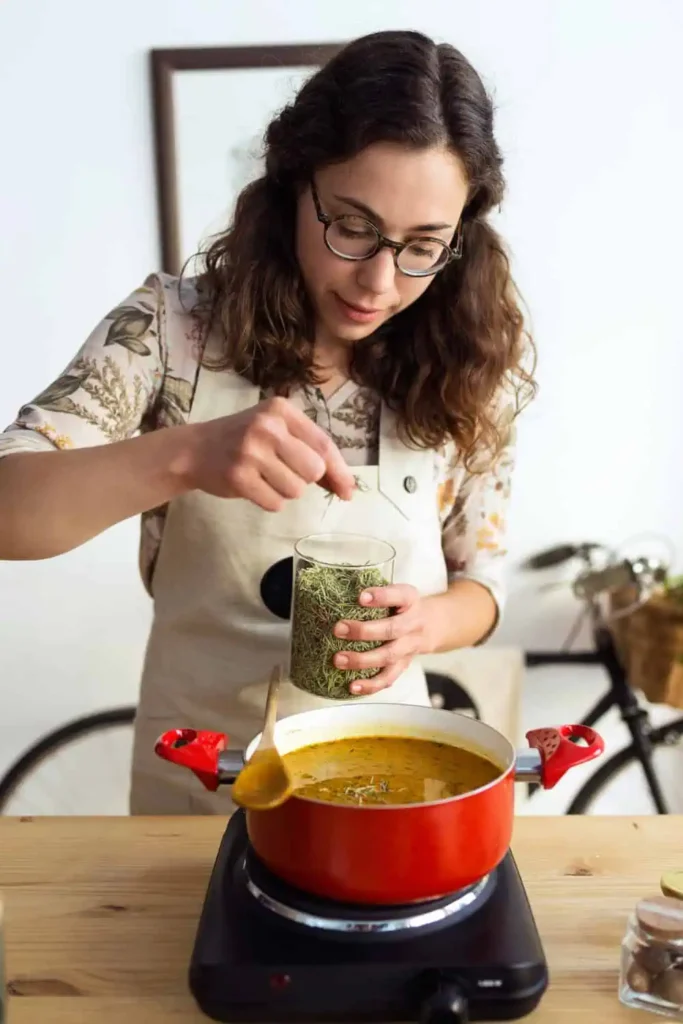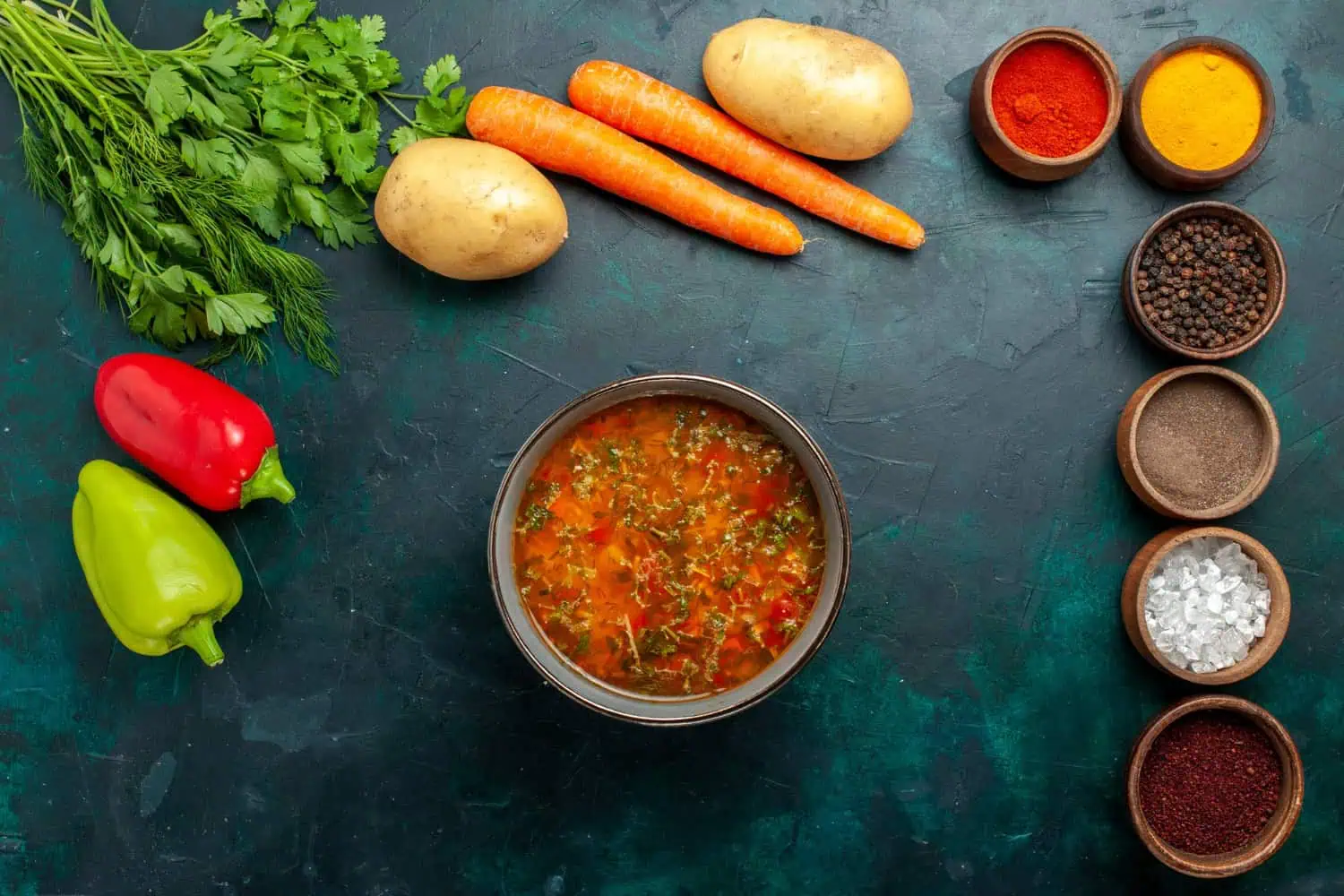Have you ever wondered what is the secret ingredient in soup that makes restaurant broths taste so much better than homemade versions? What is the secret ingredient in soup? The truth is, there isn’t just one secret – there are several game-changing ingredients and techniques that professional chefs use to create those deeply flavorful soups we all love. In this comprehensive guide, we’ll explore the various elements that transform an ordinary soup into an extraordinary culinary experience.
Whether you’re making a hearty vegetable soup, a creamy bisque, or a clear broth, the secret to success lies in understanding how to layer flavors, balance ingredients, and use a few surprising additions to elevate your soup to the next level. Let’s dive into the secrets of soup-making and uncover the ingredients and techniques that will make your soups unforgettable.
The Foundation of Exceptional Soup Making
Before diving into secret soup ingredients, it’s essential to understand that great soup starts with proper technique. The foundation of any excellent soup lies in:
- Proper seasoning at every stage
- Quality base ingredients
- Correct cooking temperatures
- Balanced flavors
- Appropriate cooking times
- Fresh, high-quality produce
Why Technique Matters
The way you prepare your soup is just as important as the ingredients you use. For example, sautéing aromatics like onions, garlic, and celery before adding liquid helps release their natural sugars and enhances the overall flavor. Similarly, simmering instead of boiling ensures that the flavors meld together without becoming harsh or overcooked.
The Role of Stock in Soup
A high-quality stock is the backbone of any great soup. Whether you’re using chicken, beef, vegetable, or seafood stock, the depth of flavor it provides is unmatched. Homemade stock is always preferable because it allows you to control the ingredients and avoid preservatives or artificial flavors. If you’re short on time, opt for high-quality store-bought stock, but enhance it with aromatics, herbs, or umami-rich ingredients like miso or soy sauce.
Understanding the Science Behind Flavor Development
The development of rich, complex flavors in soup involves several chemical processes:
- Maillard Reaction: Browning ingredients like onions, garlic, or meat creates deep, savory flavors.
- Flavor Compound Extraction: Simmering bones, vegetables, or spices allows their flavors to infuse the broth.
- Emulsification: In cream-based soups, fats and liquids combine to create a smooth, velvety texture.
- Gelatin Development: When using bones, the collagen breaks down into gelatin, giving the soup a rich, silky mouthfeel.
- Caramelization: Roasting vegetables or tomato paste before adding them to the soup enhances their natural sweetness.
The Importance of Texture in Soup
While flavor is critical, texture plays an equally important role in creating a satisfying soup. A silky bisque, a chunky vegetable soup, or a hearty stew all rely on the right balance of ingredients and cooking techniques to achieve the desired consistency. For creamy soups, blending with an immersion blender or adding cream can create a luxurious texture. For brothy soups, straining and skimming impurities ensures clarity and smoothness.
Top Secret Ingredients That Transform Ordinary Soup
1. Umami Boosters
Umami, often referred to as the “fifth taste,” is the key to creating deeply satisfying soups. The most powerful secret ingredients for soup often pack an umami punch:
- Fish sauce: Just a few drops can add incredible depth to broths and stews.
- Dried mushrooms: Shiitake or porcini mushrooms are excellent for adding earthy, savory notes.
- Parmesan rinds: Tossing a rind into the pot while the soup simmers infuses it with a nutty, cheesy flavor.
- Miso paste: A spoonful of miso adds a salty, umami-rich complexity.
- Worcestershire sauce: This classic condiment is a blend of umami-packed ingredients like anchovies and tamarind.
- Anchovy paste: A small amount dissolves into the soup, adding depth without a fishy taste.
- Dried seaweed: Kombu or nori can enhance broths, especially in Asian-inspired soups.
- Soy sauce: A splash of soy sauce can replace salt while adding a savory kick.
- Nutritional yeast: A vegan-friendly option that adds a cheesy, umami flavor.
- MSG (optional): While controversial, MSG is a concentrated source of umami that can enhance soups.
2. Aromatic Enhancers
Aromatics are the backbone of any flavorful soup. These ingredients add depth and complexity:
- Bay leaves: A classic addition to broths and stews, bay leaves add subtle herbal notes.
- Fresh herbs: Parsley, thyme, rosemary, and dill can brighten and enhance the flavor of soups.
- Roasted garlic: Roasting garlic mellows its sharpness and brings out its natural sweetness.
- Caramelized onions: Slowly cooking onions until golden brown adds a rich, sweet flavor.
- Bouquet garni: A bundle of herbs tied together or placed in a cheesecloth makes it easy to infuse flavor and remove them later.
- Lemongrass: Perfect for Asian-inspired soups, lemongrass adds a citrusy, aromatic note.
- Star anise: A single star anise can add a subtle licorice flavor to broths.
- Fennel: Adds a sweet, slightly anise-like flavor that pairs well with seafood soups.
- Celery root: A more intense version of celery, it adds depth to vegetable-based soups.
3. Acid Elements
Acidic ingredients are often the secret soup ingredients that brighten flavors and balance richness:
- Lemon juice: A squeeze of fresh lemon at the end of cooking can lift the entire dish.
- Vinegars: Apple cider vinegar, red wine vinegar, or balsamic vinegar can add complexity.
- White wine: Deglazing the pot with wine adds acidity and depth.
- Tomato paste: Adds both acidity and umami, especially when caramelized before adding liquid.
- Citrus zest: Lemon, lime, or orange zest can add a fresh, aromatic note.
- Fermented vegetables: Kimchi or sauerkraut brine can add tanginess and complexity.
- Pickle brine: A splash of pickle juice can enhance soups like borscht or potato soup.
- Tamarind paste: Adds a tangy, slightly sweet flavor to soups.
- Sumac: A Middle Eastern spice that adds a tart, lemony flavor.
- Verjus: The juice of unripe grapes, verjus is a milder alternative to vinegar.

Professional Chef’s Secret Techniques
Building Layers of Flavor
To create restaurant-quality soup, it’s essential to build layers of flavor:
- Start with sautéed aromatics: Onions, garlic, celery, and carrots are often the first step.
- Deglaze the pot: Use wine, vinegar, or broth to scrape up browned bits from the bottom of the pot.
- Use homemade stock: Whenever possible, use homemade chicken, beef, or vegetable stock for the best flavor.
- Season gradually: Add salt and spices in stages to avoid over-seasoning.
- Let flavors develop slowly: Simmering soup over low heat allows the ingredients to meld together.
The Power of Proper Seasoning
Understanding when and how to season is crucial:
- Salt in stages: Add salt gradually to avoid over-salting.
- Use fresh ground pepper: Freshly ground black pepper has a more vibrant flavor than pre-ground.
- Balance sweet and savory: A pinch of sugar can balance overly acidic or bitter flavors.
- Adjust acid levels: Add a splash of vinegar or lemon juice at the end to brighten flavors.
- Taste frequently: Always taste as you go to ensure the flavors are balanced.
Common Mistakes to Avoid
When searching for the perfect secret ingredient in soup, avoid these pitfalls:
- Over-salting early in the cooking process
- Boiling instead of simmering
- Skipping the sautéing step
- Using low-quality ingredients
- Adding too many competing flavors
- Overcooking vegetables
- Not skimming impurities from the surface
- Using old or stale spices
- Rushing the cooking process
- Improper storage methods
Special Ingredients for Different Soup Styles
Clear Broths
- Kombu seaweed
- Dried bonito flakes
- Whole spices (like cloves or allspice)
- Fresh ginger
- Green onion
- Dried mushrooms
- Charred onions
- Roasted bones
- Fresh herbs
- Aromatic vegetables
Cream-Based Soups
- Nutmeg
- Heavy cream
- White pepper
- Sherry
- Fresh herbs
- Mascarpone
- Crème fraîche
- Butter
- Roasted garlic
- Infused oils
Vegetable Soups
- Smoked paprika
- Nutritional yeast
- Miso paste
- Roasted vegetables
- Herb oils
- Cashew cream
- Coconut milk
- Fermented vegetables
- Fresh herbs
- Quality olive oil
The Role of Time in Soup Making
One often overlooked secret ingredient in soup is time. Allowing your soup to simmer slowly and rest before serving can make a significant difference in flavor. Here’s why time matters:
- Flavors meld together: Simmering allows the ingredients to combine and develop a cohesive flavor.
- Gelatin extraction: When using bones, longer cooking times allow collagen to break down into gelatin, creating a rich texture.
- Overnight resting: Many soups taste better the next day as the flavors continue to develop.
- Proper reheating: Gently reheating soup ensures that the flavors remain intact without overcooking.
Advanced Stock-Making Techniques
Bone Broth Secrets
- Roast bones first to enhance their flavor.
- Add acid (like vinegar) to help extract collagen.
- Simmer gently for hours to extract maximum flavor.
- Use a mix of bones (marrow, knuckles, etc.) for a balanced broth.
- Skim impurities regularly for a clear broth.
Vegetable Stock Enhancement
- Roast vegetables for a deeper flavor.
- Use mushroom stems or dried mushrooms for umami.
- Add kombu for a subtle seaweed flavor.
- Include aromatic herbs like thyme and parsley.
- Avoid overcooking to prevent bitterness.

FAQs About Soup Secret Ingredients
What makes restaurant soup taste better than homemade?
Restaurants often use concentrated stocks, professional-grade ingredients, and proper seasoning techniques that develop deeper flavors. They also have the advantage of making large batches, which allows flavors to develop more fully.
How can I make my soup more flavorful?
Layer your flavors, use fresh ingredients, and don’t forget to add umami-rich elements like parmesan rinds or fish sauce. Additionally, proper seasoning throughout the cooking process and allowing adequate time for flavor development are crucial.
What is the best secret ingredient for vegetable soup?
Nutritional yeast or miso paste can add depth and umami flavor to vegetable soups without using animal products. Roasting vegetables before adding them to the soup also significantly enhances flavor.
Should I add salt at the beginning or end of cooking soup?
Season throughout the cooking process, but be conservative early on as the liquid reduces and flavors concentrate. Final seasoning adjustments should be made just before serving.
How do I fix bland soup?
Add acid (lemon juice or vinegar), umami elements, or fresh herbs. Sometimes, simply letting it simmer longer helps develop flavor. You can also try adding a parmesan rind or a splash of fish sauce.
What’s the best way to store homemade soup?
Cool soup properly before storing in airtight containers. Refrigerate for up to 5 days or freeze for up to 3 months. Always reheat gently to preserve flavors and textures.
Tips for Storing and Serving
To maintain the impact of your secret soup ingredients:
- Cool properly before storing
- Store in airtight containers
- Freeze in portions
- Reheat gently
- Adjust seasoning before serving
- Label and date containers
- Use appropriate storage vessels
- Consider ingredient stability
- Plan for reheating
- Garnish freshly when serving
Professional Garnishing Techniques
Fresh Herbs and Aromatics
- Chiffonade of fresh herbs
- Microgreens
- Edible flowers
- Herb oils
- Crispy aromatics
Textural Elements
- Croutons
- Crispy vegetables
- Toasted nuts
- Seeds
- Cream swirls
Conclusion
The real secret ingredient in soup isn’t just one magical addition – it’s the combination of quality ingredients, proper technique, and patience. By understanding how different elements work together and taking the time to build layers of flavor, you can create soups that rival your favorite restaurant versions. Remember that the best soups often benefit from a balance of umami, acid, and aromatic elements, along with proper seasoning throughout the cooking process.
Whether you’re making a simple broth or a complex cream soup, these principles and secret ingredients will help you achieve the depth of flavor you’re seeking. Start experimenting with these techniques and ingredients, and you’ll soon discover your own signature soup style that friends and family will rave about. The key is to approach soup-making as a journey of discovery, where each pot teaches you something new about flavor development and ingredient combinations.
With these tips, you’re well on your way to mastering the art of soup-making. So grab your pot, gather your ingredients, and start creating soups that warm the heart and satisfy the soul!

